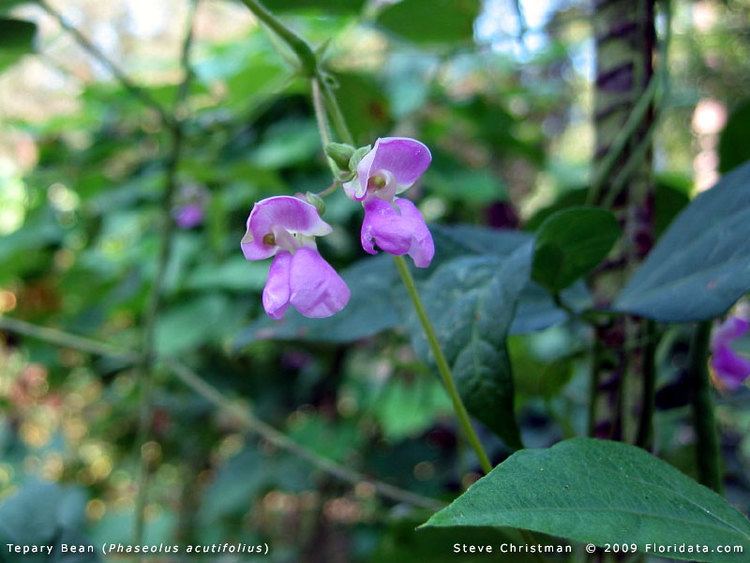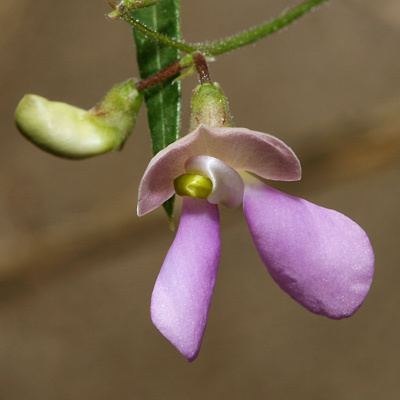Rank Species | Genus Phaseolus Higher classification Wild bean | |
Similar Wild bean, Legumes, Moth bean, Runner bean, Lima bean | ||
Fitomejoramiento en phaseolus acutifolius tepary
Phaseolus acutifolius, the Tepary bean, is native to the southwestern United States and Mexico and has been grown there by the native peoples since pre-Columbian times. It is more drought-resistant than the common bean (Phaseolus vulgaris) and is grown in desert and semi-desert conditions from Arizona through Mexico to Costa Rica. The water requirements are low and the crop will grow in areas where annual rainfall is less than 400 mm (16 in).
Contents

Description

The tepary bean is an annual and can be climbing, trailing, or erect with stems up to 4 m (13 ft) long. A narrow leafed, variety tenuifolius, and a broader leafed, variety latifolius, are known. Domestic varieties are derived from latifolius. In the Sonora desert, "the flowers appear with the summer rains, first appearing in late August, with the pods ripening early in the fall dry season, most of them in October." The beans can be of nearly any color. There are many local landraces. Beans vary in size but tend to be small. They mature 60 to 120 days after planting.

Other names for this native bean include Pawi, Pavi, Tepari, Escomite, Yori mui, Yorimuni and Yori muni. The name tepary may derive from the Tohono O'odham phrase t'pawi or "It's a bean". It should be noted that the name for a small bean was recorded in the 17th century, in the now extinct Eudeve language of northern Mexico, as tépar (accusative case, tépari). Names that contain yori in them typically refer to non-native species of beans since those names mean 'non-Indian person's bean'.
Cultivation

Tepary beans are the most drought tolerant legume. Germination, however, requires wet soil although the plants will flourish in dry conditions thereafter. Too much water inhibits bean production. Cultivated beans have been found dating to 5,000 BCE in the Tehuacán Valley in Mexico. They were cultivated by Indians by various methods, most commonly after an infrequent rain in the desert or after flood waters along a river or ephemeral stream had subsided. The tepary bean is relatively disease free, except under conditions of high humidity.

The tepary bean was a major food staple of Indians in the Southwestern United States and northern Mexico. In addition to being grown in floodplains, it was often grown alongside squash and corn. Growing these plants together, known as Three Sisters agriculture, both enhances their growth and provides more balanced nutrition.
In the United States, the tepary bean was introduced to Anglo farmers in the 19th century by Tohono O'Odham (Papago) farmers. The Indian method of planting in the American Southwest was to plant three to five seeds in hills six to eight feet apart. Beans were planted in arroyos that had been recently flooded by summer rain.
Cultivation of tepary beans is possible under the most extreme conditions. The Sand Papago (Hia C-eḍ O'odham) were mainly hunter-gatherers but cultivated tepary beans and other crops when moisture made it possible for them to do so. In 1912, ethnographer Carl Lumholtz found small cultivated fields primarily of tepary beans in the Pinacate Peaks area of Sonora. In the Pinacate, with an average annual precipitation of 75 mm (3.0 in) and temperatures up to 48 °C (118 °F), Papago and Mexican farmers utilized runoff from sparse rains to grow crops. In the 1980s author Gary Paul Nabhan visited this area, and found one farm family taking advantage of the first large rain in six years, planting seeds in the wet ground and harvesting a crop two months later. The most successful crops were tepary beans and a drought-adapted squash. Nabhan calculated that the cultivation in the Pinacate was the most arid area in the world where rain-fed agriculture is practiced.
Northwestern Mexico is the primary area of production for tepary beans. The tepary is also cultivated in many countries in Africa, Australia, and Asia. In India, tepary beans are an ingredient in the snacks 'bhujia' and Punjabi Tadka by Haldiram's.
As of 2015, the International Center for Tropical Agriculture in Colombia is testing crossbreeds of the tepary bean and common bean, in order to impart the tepary's drought and heat resistance. The latter could be especially helpful given climate change's effects on agriculture.
Medicinal uses
Research in the United States and Mexico suggest that lectin toxins and other compounds from tepary beans may be useful in chemotherapy for treating cancer. However, further research is needed.
